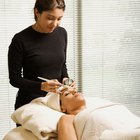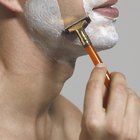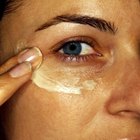
Rosy cheeks are considered a sign of vibrant good health, but red chapped cheeks -- often a result of exposure to sunlight, cold wind or dry indoor air -- are itchy, annoying and unattractive. Without intervention, chapped cheeks may become painful. Prevention and treatment of dry, chapped cheeks isn't difficult. However, protecting your face from the elements and restoring moisture to your skin requires tender loving care every day.
Step 1
Take warm baths or showers because hot water can dry the skin. Limit baths and showers to no more than 15 minutes.
Step 2
Wash your face with a gentle, moisturizing cleanser. Avoid products with deodorants, alcohol or fragrance. Pat your cheeks dry with a soft towel or let them air-dry.
Step 3
Apply moisturizing lotion, ointment or petroleum jelly to your cheeks after bathing, while your skin is still warm and moist. Reapply moisturizer as needed throughout the day and before bedtime. Use a noncomedogenic moisturizer if you have acne because the product won't clod your pores.
Step 4
Protect your cheeks with sunscreen every time you go outdoors, even on cloudy days. Use a product with an SPF of at least 15 and reapply often.
Step 5
Treat your cheeks to a moisturizing facial mask once every week. Use a commercial product or coat your cheeks with a small amount of mayonnaise. Leave the mayonnaise on your cheeks for 20 minutes and then rinse thoroughly.
Step 6
Drink at least eight glasses of water every day to keep your skin hydrated.
Step 7
Set the thermostat at 70 degrees or lower during the winter because warm, dry air contributes to chapped, irritated skin.
Step 8
Use a humidifier in your home to keep the air moist. Clean the humidifier regularly.
Related Articles

How to Reduce Facial Redness From ...

How to Prevent Pock Holes From ...

Help for Red Marks After Facials

How to Reduce Redness

How to Take Care of Wrinkled Hands

How to Get Rid of All the Tiny Embedded ...

How to Have Nice Knees

How to Have Flawless Armpits

How to Even Out Skin Tone Without Makeup

How to Stop Facial Redness From Shaving

How to Use Vaseline as a Moisturizer ...

Yogurt Face Mask for Acne

How to Get Rid of Irritation From ...

The Best Facial Moisturizer That Won't ...

How to Get a Closer Electric Shave

Are There Ways to Get Rid of Blocked ...

How to Take Care of Your Skin in a Hot ...

The Best Facial Moisturizers for People ...

How to Get Dark Ankles Lighter

What Is the Difference Between Oily & ...
References
Writer Bio
M.H. Dyer began her writing career as a staff writer at a community newspaper and is now a full-time commercial writer. She writes about a variety of topics, with a focus on sustainable, pesticide- and herbicide-free gardening. She is an Oregon State University Master Gardener and Master Naturalist and holds a Master of Fine Arts in creative nonfiction writing.
Photo Credits
Creatas/Creatas/Getty Images